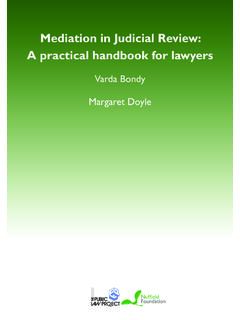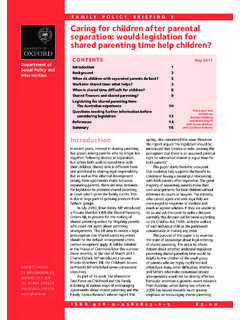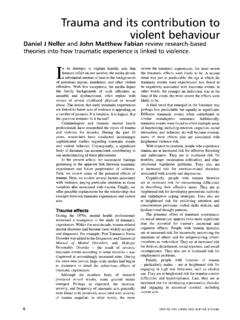Transcription of Has parenting changed over recent decades?
1 Has parenting changed over recent decades? Can changes in parenting explain the rise in adolescent problem behaviour? Professor Frances Gardner, University of Oxford Dr Stephan Collishaw, Cardiff University Professor Barbara Maughan, Kings College London Professor Jacqueline Scott, Cambridge University WORKING PAPER SUBMITTED TO THE NUFFIELD FOUNDATION JULY 2009 This paper is undergoing revision, and will result in several different publications. Not for citation in current form 2 Please direct all correspondence to: Professor Frances Gardner Department of Social Policy and Social Work, University of Oxford, Barnett House, 32 Wellington Square, Oxford OX1 2ER England. Telephone: +44 (0) 1865 270325 Working Paper Not for Citation NUFFIELD FOUNDATION CHANGING ADOLESCENCE PROGRAMME Working paper July 2009 Has parenting changed over recent decades? Can changes in parenting explain the rise in adolescent problem behaviour?
2 Frances Gardner, Barbara Maughan, Jacqueline Scott and Stephan Collishaw 1. OVERVIEW Adolescent problem behaviour has shown rising trends over the last 50 years (Rutter & Smith, 1995). Among the many factors canvassed as possible contributors to these trends , concerns over declines in the quality of family life and parenting have loomed large in both public and policy debate (Ambert, 2006; Margo & Dixon, 2006; DfES 2006). patterns of family formation and levels of family disruption have clearly shown major changes over that period, as have the patterns of parents working lives. Given these demographic trends , it seems plausible to assume that more proximal indicators of parenting well-established predictors of problem behaviour within any generation of young people may also have changed at the same time. To date, however, very little is known about the evidence for these assumptions; few commentators have attempted to bring together extant data on time trends in parenting , and no studies have examined the extent to which they could account for rising levels of problem behaviour in the young.
3 That is the purpose of this review. Focusing on selected aspects of parenting (those found to be well-replicated risk factors for problem behaviour in longitudinal studies, and effective targets for change in intervention trials), we (i) reviewed existing literature on trends in parenting of adolescents in western societies over the last half century, with a particular emphasis on the UK and (ii) undertook new analyses of UK data sets with measures of relevant constructs. We reached three main conclusions. First, we found that published evidence on trends in parenting is both patchy and limited; our new analyses could fill some, but by no means all, of those gaps. Second, such trends as did emerge gave few suggestions of declines in parenting ; instead, current evidence points to apparent improvements in a number of indicators of parents involvement with and supervision of their adolescent children.
4 Third, we found no published studies that directly brought together associations between parenting and problem behaviours at different points in time: so far as we are aware, the new analyses that we present at the end of this report are novel in this respect. They analyses highlighted parental mental health, and to a lesser extent family type and social disadvantage, as of potential importance in understanding trends in youth problem behaviour. We conclude by offering some reflections on possible implications of these findings for understanding time trends in adolescent behaviour problems, and for future research on trends in parenting . Working Paper Not for Citation 4 Our report falls into 9 sections. Section 2 forms the background, beginning with a brief description of trends in adolescent problem behaviour and in family demographic indicators between the 1970s and the early 2000s.
5 We then present the model of parenting and its relationship to adolescent problem behaviour that guided our review, and set out a number of conceptual and methodological issues relevant to the study of time trends in parenting . Section 3 outlines our research questions, and Section 4 describes both the methods of the literature review and our secondary analysis of UK trend data concerning parenting behaviour. Sections 5-8 present the results; Section 9 provides summary, conclusions and recommendations. 2. BACKGROUND Why problem behaviour? We define problem behaviour in adolescence to include behaviours that are antisocial, aggressive and disruptive. Behaviours of this kind are of interest to researchers and policy-makers in a range of disciplines; as a result, they are defined and assessed in a variety of differing but overlapping ways. For the criminologist, the prime focus is on delinquency: behaviours such as theft, serious property damage, fraud, public disorder, and assaults, all of which can attract legal sanctions.
6 Both self-report delinquency studies and official records of recorded crime show that involvement in offending is at its highest in the teens. Much recent UK policy debate has focused on the rather different concept of antisocial behaviour a term that ..tends to be used to refer to a range of criminal and non-criminal activities which are likely to cause harassment, alarm or distress and impact on people s quality of life (Home Office, 2008). The psychiatric and developmental literatures (broadly, the prime sources for our evidence here), have a somewhat broader focus, including not only illegal and harassing behaviours but those that involve disobedience or disruptiveness in the home (such as lying, staying out late, deliberately annoying others and refusing to comply with rules); while the frequency of many of these behaviours also peaks in the teens, many are also common at much younger ages. In the psychiatric literature, conduct disorder is classified as a mental health problem.
7 Although it is distinct from emotional disorders such as depression and anxiety, it is not uncommon for such difficulties to co-occur with conduct disorder. Problem behaviours share in common that they are troublesome and costly to communities, families, schools and the justice system. Some youth show adolescent onset problems; those with more frequent and persistent problem behaviour tend to have started these patterns earlier in childhood; they are also at raised risk for poor outcomes in youth and adult life, including school failure, mental illness, substance use and poor employment prospects. trends in adolescent problems A variety of evidence highlights the increasing prevalence of all kinds of adolescent mental health problems over recent decades (Rutter & Smith, 1995; Maughan et al., 2005). Evidence from a recent Nuffield Foundation-funded study using comparable measurements from repeated cross-sectional UK surveys showed substantial increases in both adolescent conduct and emotional problems over the last 25 years of the 20th Working Paper Not for Citation 5 century (Collishaw et al.)
8 , 2004). More recent comparisons show that rates of problem behaviour have since plateaued or begun to decrease (Figure ). Figure trends in parent-rated conduct problems over four nationally representative UK cohorts of youth (aged 15-16). These findings were based on opportunistic comparisons of available data-sets. In section 8 we present new data on trends in behaviour problems between 1986 and 2006 taken from a study specifically designed to track secular trends ; this showed closely similar results. Because the time-points sampled in both of these studies are some years apart, we cannot be certain of the precise shape (and in particular the peak) of any underlying trend. It is worth noting, however, that aggregate crime data (recorded annually, but not specific to youth crime ) show a similar pattern, including an increase across the 1970s and 1980s; they peaked in the early-mid 1990s, and have since shown a sustained reduction up to the present time (Figure ).
9 Figure crime rates Note: change in counting rules applies to officially recorded crime 2 51. 51974198619992004 BoysGirlsWorking Paper Not for Citation 6 Can changes in family-related demographics explain these trends ? Why did problem behaviour increase so much over such a relatively short historical period? To many, the answer may seem obvious: much the same time period also saw massive changes in family life, with the increasing breakdown of the traditional family, rising numbers of absent fathers, and more mothers returning to work when their children are very young. Detailed accounts of these and related changes can be found elsewhere (Ferri et al., 2003; Halsey & Webb, 2000; Machin, 2008, Scott et al., 2004). We highlight trends in just a few of the key indicators here: Sources: Office for National Statistics (2008); Dench et al, 2002; At the individual level, we know that many of these factors are associated with problem behaviour; surely then they must form a large part of the explanation for the secular change?
10 Perhaps surprisingly, relatively few studies have examined this question and those that have have reached somewhat unexpected conclusions. In particular, findings from a study based directly on data for the first 3 UK cohorts shown in Figure 1 argued strongly against any simplistic view that changes in family type were major drivers of the rise in conduct problems (Collishaw et al, 2007). Though many more adolescents were indeed living in single parent and step-families in more recent cohorts, the data were striking in showing a steep rise in problem behaviour in all family types, and changes in family structure accounted for only around 10% of the rise in problem behaviour. So far as we are aware this is the only study to have examined these issues directly to date. If its conclusions hold more generally, however, and changes in family structure alone cannot explain the rise in conduct problems - could it be that the quality or quantity of parenting has changed ?

















